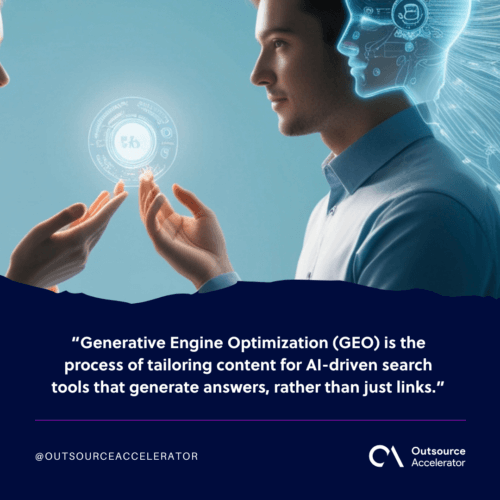Getting started with Generative Engine Optimization (GEO)

Ranking high on search engines has become more complex than ever. Competition grows daily, algorithms constantly evolve, and traditional SEO tactics don’t always deliver.
As artificial intelligence transforms how content is created, it’s also reshaping how search engines evaluate and rank pages.
Marketers now face a new frontier, balancing human intent with machine logic. This shift has introduced a significant approach known as generative engine optimization.
Mastering generative engine optimization may be the key to gaining visibility in an era where AI drives content discovery and search behavior. This article sheds light on what GEO involves and why it matters.
What is Generative Engine Optimization (GEO)?
Generative Engine Optimization (GEO) is the process of tailoring content for AI-driven search tools that generate answers, rather than just links. Unlike traditional SEO, GEO focuses on optimizing for platforms like:
- ChatGPT
- Perplexity
- Gemini
- Google’s AI Overviews
These systems rely on large language models to interpret user intent and deliver rich, conversational responses.
GEO helps brands appear directly in those AI-generated results, increasing their chances of being discovered by high-intent audiences.
As search behavior shifts toward AI-assisted tools, GEO positions content to rank where it matters most, within the answers users receive, not just on search engine results pages.

SEO vs. GEO
SEO and GEO both aim to improve content visibility, but they operate in different environments. While traditional SEO targets search engine results pages (SERPs), GEO adapts to the growing presence of AI-generated responses.
Having a good understanding of their core differences can help marketers decide where to focus their content strategy.
Here’s a side-by-side comparison:
| Aspect | Search Engine Optimization (SEO) | Generative Engine Optimization (GEO) |
| Primary goal | Rank higher on search engine results pages | Appear in AI-generated answers and summaries |
| Content focus | Keywords, backlinks, and technical optimization | Context, clarity, and topic authority |
| Ranking system | Algorithm-based keyword and link evaluation | AI-driven language model analysis |
| User experience | Click-based navigation to websites | Direct answers within search tools and chat interfaces |
| Success factor | Domain authority, link-building, metadata | High-quality, relevant, and authoritative content |
| Search behavior targeted | Keyword-based queries | Conversational or complex search prompts |
GEO reflects how AI is modifying search behavior. Businesses that adapt to these changes by creating content that aligns with AI models will stay competitive as digital discovery continues to evolve.
Core principles of Generative Engine Optimization
Generative Engine Optimization shifts the focus from keyword stuffing to creating content that aligns with how AI-driven search engines process information. These engines prioritize context, clarity, and genuine value.
To succeed, brands must have a deeper knowledge of how to communicate with both machines and human users in a way that reflects natural language, trust, and authority:
Determine search intent
Search intent is the foundation of GEO. It refers to the reason behind a user’s query, what they truly want to find or accomplish.
AI-powered search engines don’t just look for matching phrases; they interpret the meaning behind the question. High-performing GEO content speaks directly to that intent.
Writers should craft articles using conversational language, focus on long-tail keyword phrases, and present information clearly through direct answers, bullet points, and actionable tips.
For example, instead of targeting a general phrase like “SEO tips,” content should target specific, intent-driven queries like “how to use AI for SEO audits.”
Align with E-E-A-T standards
Google’s E-E-A-T framework (Experience, Expertise, Authoritativeness, and Trustworthiness) remains critical in a GEO strategy:
- Content that reflects real-world experience builds credibility.
- Demonstrating expertise means relying on verified data and in-depth research.
- Linking to reputable sources and industry voices enhances authority.
Ultimately, trust is built through transparency, clear authorship, accurate data handling, and honest communication. Meeting these criteria improves both visibility in generative search and user confidence.
As you can see, Generative Engine Optimization is a user-first approach to modern content creation.
How can Generative Engine Optimization help your digital footprint?
Generative Engine Optimization (GEO) has become essential for staying visible and relevant. Traditional SEO methods now compete with AI models that prioritize context, intent, and quality.
Adapting to GEO gives brands an edge in an increasingly intelligent search environment:
Improves content discoverability
GEO helps content appear in more nuanced and complex searches. AI-powered engines go beyond simple keyword matching to understand intent, phrasing, and context.
When content reflects natural language and intent-based keywords, it becomes easier for generative search tools to surface it as a reliable result. This leads to more frequent visibility in voice searches, chatbots, and AI-generated responses.
Increases user engagement
Content that aligns with GEO principles speaks directly to what users want. Instead of vague answers, it delivers specific, actionable information. Users are more likely to stay on the page, click through related links, and interact with helpful elements like lists, examples, and how-tos.
Better engagement signals content value, which AI-driven platforms reward with higher rankings.

Future-proof SEO strategy
Search engines are moving toward AI-first indexing models. GEO positions content to thrive in this future. Brands that adapt early avoid losing traffic to more optimized competitors and stay ahead of evolving algorithms.
Builds brand credibility
Generative Engine Optimization emphasizes quality, accuracy, and authority. Content that reflects these values not only ranks better but also earns user trust.
Over time, this builds a stronger online presence and a more respected brand identity across digital platforms.
Generative Engine Optimization: FAQs
Here are some of the most frequently asked questions to help clarify what GEO means and how it compares to traditional SEO.
What is Generative Engine Optimization?
GEO refers to the process of optimizing content for AI-powered search engines and assistants. These platforms analyze intent, context, and conversation-style queries. It focuses on natural language, direct answers, and high-quality information.
What is the difference between SEO and GEO?
Traditional SEO focuses on keywords, metadata, and backlinks. GEO emphasizes user intent, conversational content, and contextual relevance.
Both work together to maximize visibility in today’s search environment.
Is GEO replacing SEO?
GEO is not a replacement for SEO; it is an evolution. As AI technology advances, GEO builds on SEO fundamentals while adapting to how users interact with modern search tools like voice assistants and chat-based engines.
Generative Engine Optimization represents the next step in digital content strategy, aligning with how modern users search and engage online. Adopting GEO now positions brands for greater visibility, trust, and long-term success in an AI-driven search.







 Independent
Independent




